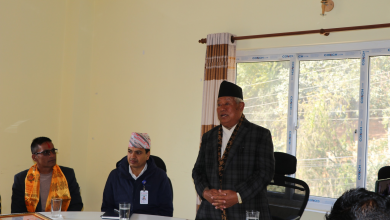18th National Paddy Day celebrated symbolically owing to COVID-19

Kathmandu: Today is the 18th National Paddy Day and Paddy Cultivation Festival. The government had decided in 2061 BS to mark Ashar 15 of the Nepali calendar every year as National Paddy Day and Paddy Cultivation Festival.
Rice plantation, eating delicacies like curd and beaten rice, and participation in traditional cultural programs like singing, throwing mud at each other and merriment, are the major attractions of the Day. But like last year, this year too there were no such big events on this occasion as the Festival was celebrated symbolically owing to COVID-19.
Paddy is the major crop not only in Nepal but also in entire South Asia. It is the main staple crop of Nepal.
But the COVID-19 pandemic has made the Festival celebrations dull for the past two years. Though farmers and private sectors celebrated the festival sporadically on their own, the celebrations from the government level were limited to formalities.
The Day was celebrated symbolically by observing all health protocols, in a bid to promote the significance of rice, encourage farmers, keep the tradition alive, and for the publicity of the Day, according to Officiating Director-General of the Department, Januka Pandit. The Department of Agriculture had directed all stakeholders and its units in the districts to mark the Festival within the limits set by the government.
The 18th National Paddy Day and Paddy Cultivation Festival this year was celebrated around the slogan – ‘Growth in Paddy Production: Food Security, Self-reliance and Prosperity’.
A national-level celebration was marked at the central level at the National Agricultural Research Council (NARC)’s farm in Khumaltar, Lalitpur on Tuesday, in the presence of the Minister for Agriculture and Livestock Development Basanta Kumar Nembang. On the occasion, the Minister planted the rice symbolically. He inaugurated the celebration by planting rice traditionally and with help of rice planting equipment.
The Ministry of Agriculture and Livestock Development has concluded that the agricultural and farming activities have to be continued by adopting the health safety standards to reduce the possibility of food and nutrition insecurity in the future.
In this connection, the government has been facilitating the regular operation of all agricultural activities even during the lockdown period imposed to stem the spread of COVID-19.
Ministry spokesperson Dr. Shreeram Ghimire said the Ministry has brought programs for expanding the area of paddy cultivation, for increasing its production, and for promoting paddy crops.
The government aims to attain self-sufficiency in rice production by conserving the land for rice cultivation, promoting clean and healthy seeds, expanding the irrigation program, and developing hybrid and disease-resistant varieties.
It is said the area under paddy cultivation has increased by one percent and the production by 1.3 percent compared to the previous year.
Paddy is cultivated on 47 percent of the total cultivable land in Nepal. The Department stated that rice is cultivated on a total of 1 million 473 thousand hectares of land in the country and the production is 5 million 621 thousand metric tonnes from this.
On the occasion, Minister Nemwang said rice is very important in terms of food and nutrition security and therefore this staple crop should be promoted. He called attention towards increasing paddy productivity utilizing research, mechanization, and modernization.
“The government is making policy arrangements not only for paddy production but also for its systematic marketing and storage. It is necessary to move ahead making timely improvements in all these aspects,” the Minister for Agriculture said.
He stressed the need for agriculture development even for materializing the government’s resolution that ‘nobody goes hungry, nobody dies of hunger. Agriculture is the dependant basis for the country’s prosperity.
Secretary of the Ministry Dr. Yogendra Kumar Karki opined that increasing paddy production would be a challenge if the research is not taken to the farmers’ doorsteps. “There is a need of maintaining a harmonization in the use of organic and chemical fertilizer. The farmers should get the fertilizers in time for boosting production. The problem would be solved once the fertilizer industry is set up within the country,” he added.
Foodgrains production in the country at present stands at 11 million 600 thousand metric tonnes. Nine million six hundred thousand metric tonnes of food grains would be sufficient in Nepal. But Nepal has been importing rice worth more than Rs 40 billion annually. According to agriculture experts, this is so because the food culture has changed.
National Planning Commission (NPC) member, Dr. Krishna Prasad Oli, pointed out the need of developing new hybrid varieties of paddy through research given the climate change impact.
National Farmers’ Commission chairperson, Dr. Prem Prasad Dangal, stressed the need of taking technology to the doorsteps of the farmers for increasing paddy production.
Executive Director of Nepal Agricultural Research Council, Dr. Deepak Bhandari suggested developing a hybrid variety of paddy to offset the growing import of fine-grain rice. He said the Council was working towards this.
He also urged farmers to cultivate the Hardinath breed of paddy which was recently launched by the Council.









प्रतिक्रिया राख्नुहोस्